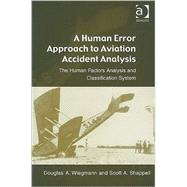
Note: Supplemental materials are not guaranteed with Rental or Used book purchases.
Purchase Benefits
Looking to rent a book? Rent A Human Error Approach to Aviation Accident Analysis: The Human Factors Analysis and Classification System [ISBN: 9780754618737] for the semester, quarter, and short term or search our site for other textbooks by Wiegmann,Douglas A.. Renting a textbook can save you up to 90% from the cost of buying.
| List of Figures | p. vii |
| List of Tables | p. x |
| Acknowledgements | p. xi |
| Preface | p. xii |
| Errare Humanum Est--To Err is Human | p. 1 |
| Aviation Safety Trends | p. 3 |
| Some Reasons for Concern | p. 8 |
| Human Error and Aviation Accidents | p. 10 |
| Engineering Aspects of an Investigation | p. 12 |
| Human Factors Aspects of an Investigation | p. 15 |
| Conclusion | p. 18 |
| Human Error Perspectives | p. 20 |
| The Cognitive Perspective | p. 21 |
| The Ergonomic Perspective | p. 26 |
| The Behavioral Perspective | p. 30 |
| The Aeromedical Perspective | p. 32 |
| The Psychosocial Perspective | p. 34 |
| The Organizational Perspective | p. 37 |
| Conclusion | p. 44 |
| The Human Factors Analysis and Classification System (HFACS) | p. 45 |
| Reason's Model of Accident Causation | p. 45 |
| Elements of a Productive System | p. 45 |
| Breakdown of a Productive System | p. 47 |
| Strengths and Limitations of Reason's Model | p. 49 |
| Defining the Holes in the Cheese | p. 50 |
| Unsafe Acts of Operators | p. 50 |
| Errors | p. 51 |
| Violations | p. 55 |
| Preconditions for Unsafe Acts | p. 56 |
| Condition of Operators | p. 57 |
| Personnel Factors | p. 60 |
| Environmental Factors | p. 61 |
| Unsafe Supervision | p. 63 |
| Organizational influences | p. 66 |
| Conclusion | p. 70 |
| Aviation Case Studies using HFACS | p. 72 |
| Sometimes Experience does Count | p. 73 |
| Human Factors Analysis using HFACS | p. 75 |
| Summary | p. 82 |
| A World Cup Soccer Game They would Never See | p. 83 |
| Human factors Analysis using HFACS | p. 86 |
| Summary | p. 90 |
| The Volcano Special | p. 91 |
| Human Factors Analysis using HFACS | p. 94 |
| Summary | p. 97 |
| Conclusion | p. 98 |
| Exposing the Face of Human Error | p. 99 |
| Quantifying Proficiency within the Fleet | p. 106 |
| Crew Resource Management Training: Success or Failure | p. 111 |
| The Redheaded Stepchild of Aviation | p. 116 |
| Conclusion | p. 121 |
| Beyond Gut Feelings... | p. 122 |
| Validity of a Framework | p. 123 |
| Factors Affecting Validity | p. 124 |
| Reliability | p. 124 |
| Comprehensiveness | p. 132 |
| Diagnosticity | p. 138 |
| Usability | p. 145 |
| Conclusion | p. 147 |
| But What About...? | p. 149 |
| References | p. 157 |
| Index | p. 163 |
| Table of Contents provided by Ingram. All Rights Reserved. |
The New copy of this book will include any supplemental materials advertised. Please check the title of the book to determine if it should include any access cards, study guides, lab manuals, CDs, etc.
The Used, Rental and eBook copies of this book are not guaranteed to include any supplemental materials. Typically, only the book itself is included. This is true even if the title states it includes any access cards, study guides, lab manuals, CDs, etc.